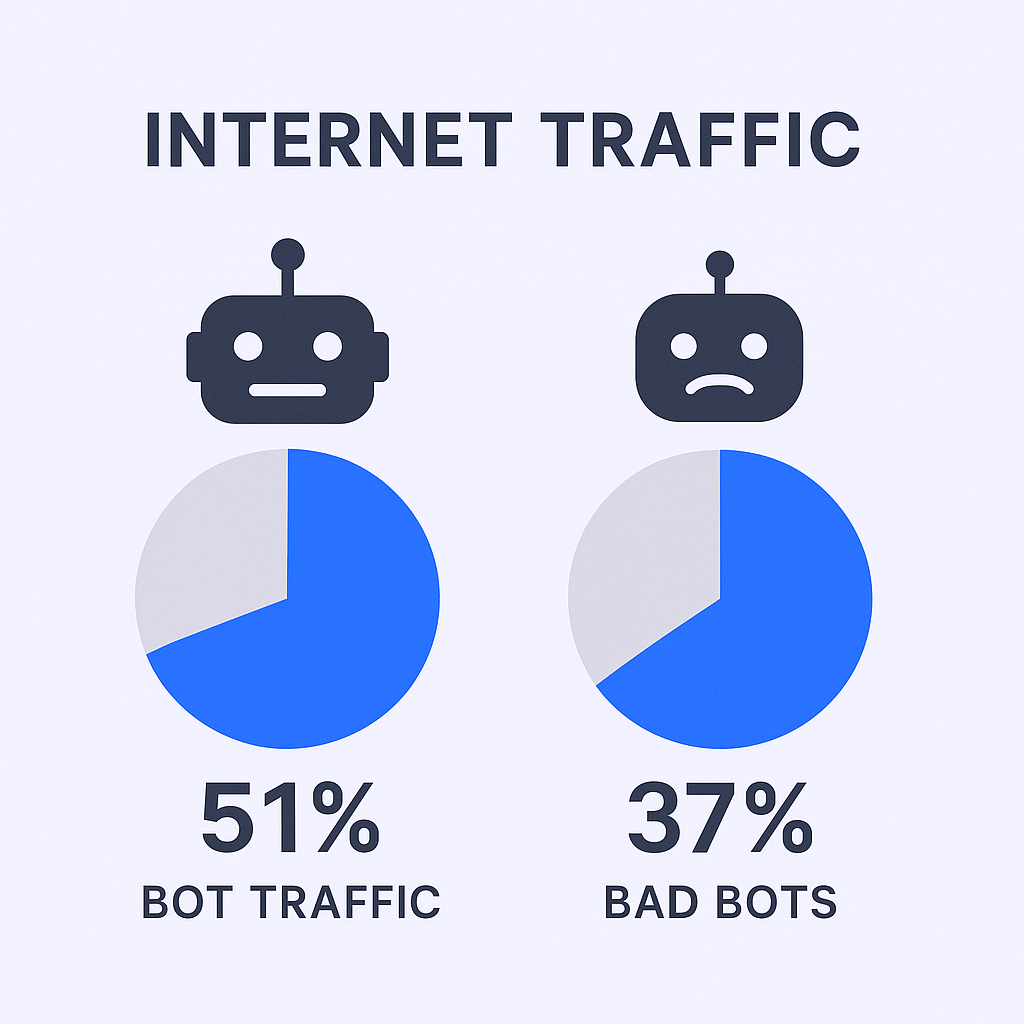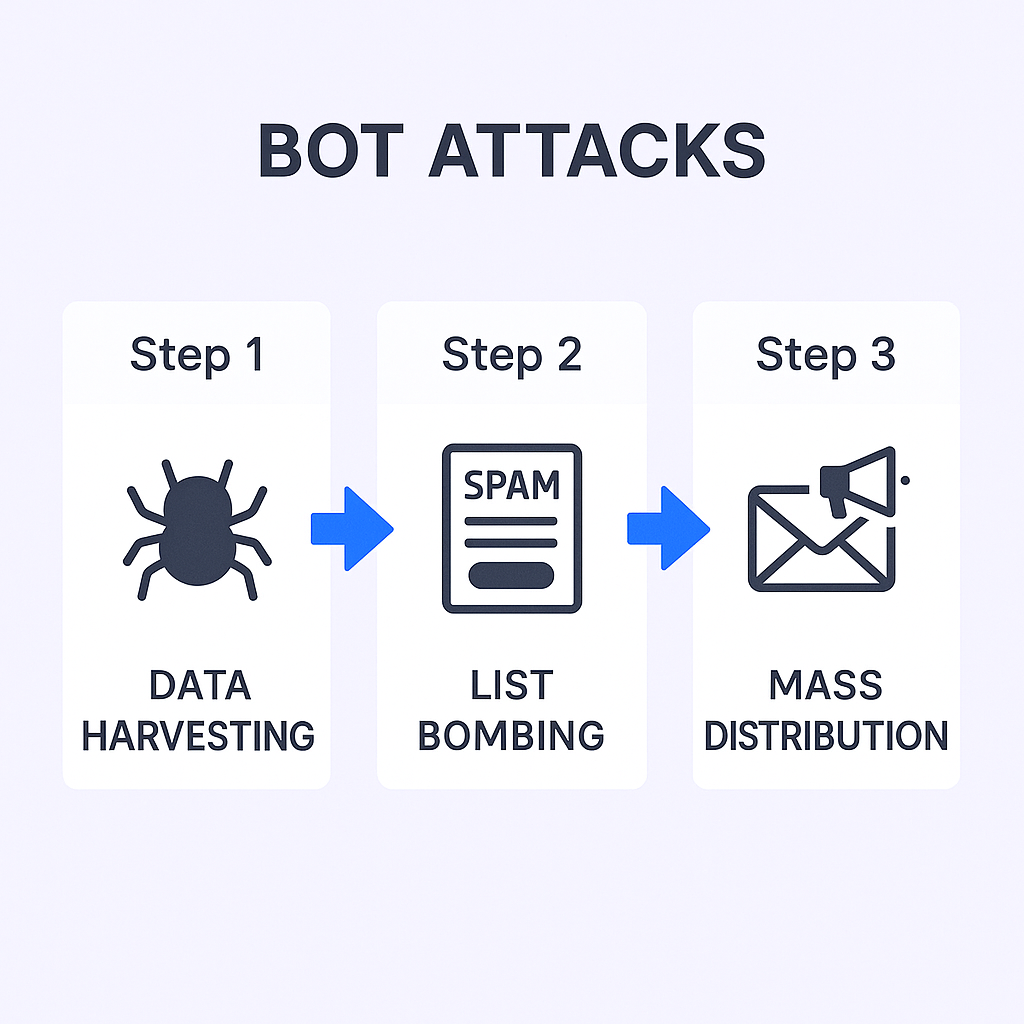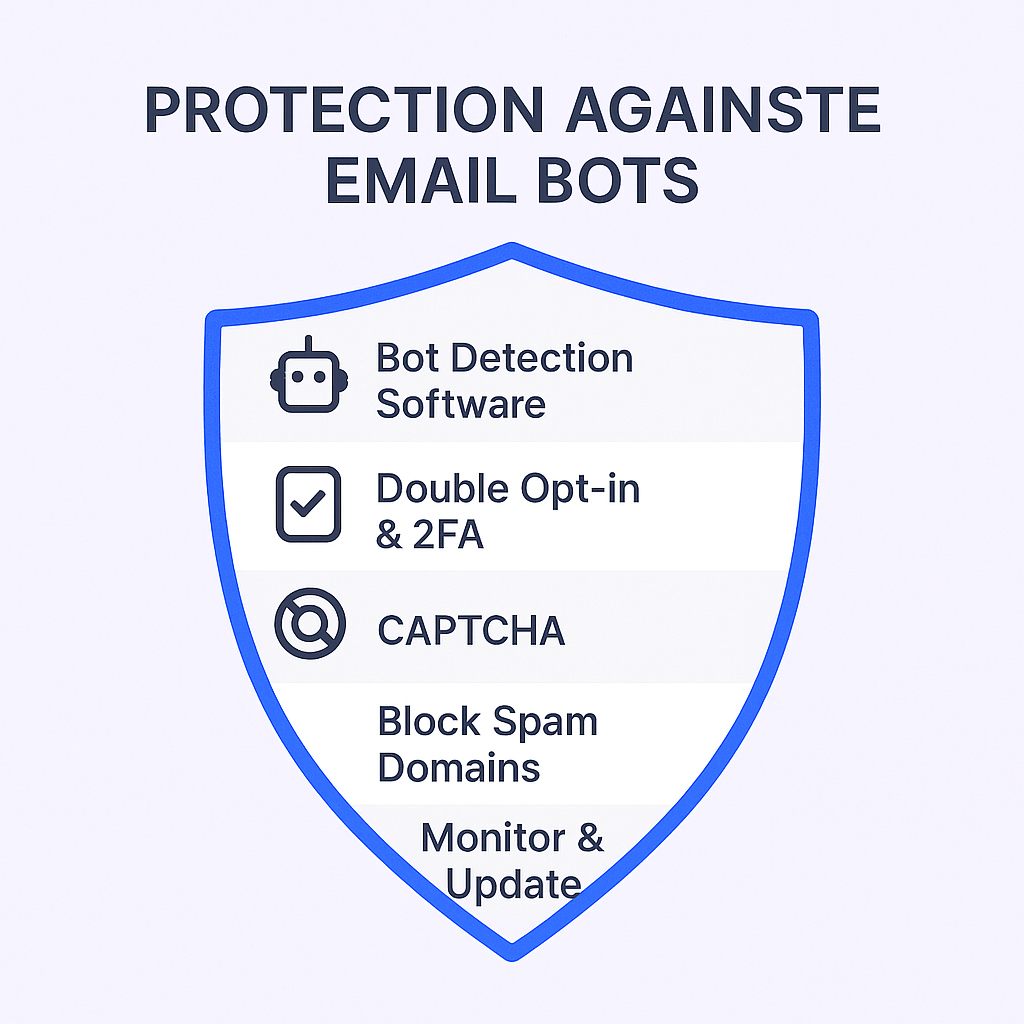- blog
- Cold Emailing
- Email Flood Bots: Silent Cold Email Killers (& How to Fight)

Email Flood Bots: Your Cold Email Campaigns' Silent Killer (And How to Fight Back!)
Table of Contents
Are Bots Drowning Your Email Efforts?
Picture this: You’ve crafted the perfect cold email, researched your prospects thoroughly, and hit send with confidence. But instead of landing in your prospect’s inbox, your carefully written message vanishes into the digital void. Even worse, your entire email list gets compromised, and your sender reputation takes a devastating hit.
Welcome to the reality of email flood bots—the silent killers of cold email campaigns.
The numbers are staggering. Automated traffic surpassed human generated activity on the internet for the first time, with automated bots now accounting for 51% of all web traffic. More concerning for sales professionals, bad bots comprised 37% of internet traffic in 2024, up from 32% the year prior.
In the email world specifically,
160 billion spam emails are sent every day, with 46% of the 347 billion daily emails sent, considered spam. That means nearly half of all email traffic is unwanted, creating a hostile environment where legitimate cold emails struggle to reach their intended recipients.
For BDRs and AEs whose success depends on effective outreach, this isn’t just an IT problem—it’s a direct threat to pipeline generation and quota achievement. When email marketing systems get flooded with bot-generated spam, your carefully crafted cold emails get caught in the crossfire, often ending up in spam filter purgatory.
But here’s the good news: You can fight back. This guide reveals five proven strategies to protect your email addresses from malicious bots and ensure your cold outreach actually reaches real prospects.
What is a Bot?
At its core, a bot is a software application that runs automated tasks over the internet. Think of it as a digital worker that never sleeps, never takes breaks, and follows its programming to the letter. Over 40% of internet traffic was reported to be driven by bots, which shows how widespread bot activities are.
Not all bots are villains in your email story. Many serve incredibly useful purposes:
Good Bots:
- Search engine crawlers that help your website get discovered by prospects
- Chatbots providing instant customer service on websites
- Social media schedulers maintaining consistent brand presence
- Monitoring bots that track website performance and uptime
Bad Bots:
- Email flood bots that harvest email addresses and send mass spam
- Form spam bots that pollute your sign-up forms with fake entries
- Scraping bots that steal your content and prospect data
⚡Don’t Fight Bots Fight Obscurity
Our LinkedIn outbound system transforms prospects into eager connections who bypass all email filters
How do Bots Work and What Are They Used For?
Email flood bots operate with surgical precision to wreak havoc on your campaigns. Here’s their typical attack pattern:
Step 1: Data Harvesting The web crawler component scans websites, social media profiles, and online directories, hunting for publicly visible email addresses. If an email address appears anywhere online, it becomes a target.
Step 2: List Bombing Spam bots flood your sign-up forms with fake entries, automatically filling out subscription forms with stolen, fake, or randomly generated email addresses that never actually opted in.
Step 3: Mass Distribution The email sender component blasts automated content to these collected addresses without any regard for recipient interest or consent.
The scale is mind-boggling. 
In 2023, between Q1 and Q2, scraping activity saw a staggering 432% rise. This explosion in automated data collection directly feeds into larger spam operations that can drown legitimate email marketing efforts.
The Disadvantages of Bots
While some bots offer genuine value, malicious email flood bots pose serious threats to your cold outreach success.
❌ Bots Can’t Always Be Set to Perform Tasks
Bots excel at repetitive, rule-based activities, but they fundamentally lack the human qualities that drive successful sales relationships. They can’t adapt to unexpected situations, think critically, or show genuine empathy.
60% of consumers believe that humans understand their needs better than a chatbot. This statistic reinforces why human BDRs and AEs remain irreplaceable for building authentic relationships and navigating complex sales conversations.
When bots encounter changes in systems or processes, they require manual updates to function correctly. Unlike humans who can instinctively recognize when something’s wrong, bots will continue executing their programmed tasks, potentially magnifying errors or causing operational failures.
❌ Humans Still Need to Manage the Bots
Even “automated” systems require human oversight. Bots need constant monitoring, updating, and debugging. They can’t self-correct when they encounter new scenarios or adapt their behavior based on changing market conditions.
For sales teams, this means you’re still spending time managing technology instead of focusing on what humans do best: building relationships and closing deals.
❌ Bots Are Used for Spam and Malicious Intent
Here’s where email flood bots become your worst nightmare. Their primary objective is financial gain through fraudulent activities, and they achieve this by:
List Bombing Your Forms Malicious bots automatically fill out your email subscription forms with thousands of fake, stolen, or invalid email addresses. When your automated campaigns send to these unverified recipients, you trigger a cascade of problems:
- Damaged Sender Reputation: High bounce rates, spam complaints, and spam trap hits devastate your sender score. Google and Yahoo maintain a spam complaint threshold of 0.3%—exceed this, and your emails get blocked.
- Reduced Deliverability: As your sender reputation tanks, even legitimate emails to real prospects end up in spam filter purgatory instead of inboxes.
- Database Pollution: Your email list gets contaminated with thousands of useless addresses, wasting resources on contacts that will never convert.
Financial Impact The cost extends far beyond wasted email sends. Bot attacks and insecure APIs are estimated to cost companies a staggering $186 billion globally. This includes direct losses from fraud, system downtime, regulatory fines, and long-term damage to brand trust.
Beyond Email Deliverability Stress
LinkedIn relationship building ensures responses regardless of spam filters and bot attacks
Book Strategy Meeting
Distribution of Malware and Phishing Spam bot networks frequently distribute malware through malicious attachments and conduct phishing scams designed to steal sensitive information. When your domain gets associated with these activities, it damages prospect trust and can lead to permanent blacklisting.
5 Ways to Protect Your Email List from Bots
Defending your email addresses from malicious bots requires a multi-layered approach. Here are five proven strategies:
Use DataDome’s Bot Detection Software
Specialized bot detection software provides your first line of defense. DataDome employs a sophisticated machine learning approach that evaluates user behavior in real-time, distinguishing human users from automated bots with remarkable accuracy.
This advanced technology adapts to new attack methods as they emerge, providing comprehensive protection against web scraping, DDoS attacks, credential stuffing, and fraud. By filtering out malicious bot traffic, such solutions reduce server strain and ensure faster load times for legitimate users.
While sophisticated bots attempt to bypass defenses using stealth browsers or residential proxies, platforms like DataDome continuously update their algorithms to identify subtle behavioral inconsistencies and browser signatures that reveal automated activity.
Introduce Double Opt-in and Two-Factor Authentication
Strong authentication measures are crucial for maintaining a clean, engaged email list.
Double Opt-in (DOI) requires an additional confirmation step beyond initial signup. After subscribing, users receive a confirmation email address with a verification link they must click to join your email list. This process effectively prevents spam bot infiltration, as bots typically cannot complete human-centric verification steps.
Double opt-in significantly enhances email deliverability rates, lowers bounce rates, and builds subscriber trust. While you might see around 20% drop-off during confirmation, the trade-off is a more engaged, genuinely interested audience that’s far more likely to convert.
Two-Factor Authentication (2FA) adds an extra security layer for user accounts. While SMS-based codes can be vulnerable to sophisticated bots, stronger methods exist:
- App-based authentication (Google Authenticator, Authy)
- Hardware tokens for maximum security
- Adaptive Multi-Factor Authentication that assesses login risk
Make Use of CAPTCHA
CAPTCHA (Completely Automated Public Turing test to tell Computers and Humans Apart) presents challenges that are easy for humans but difficult for automated programs. These tests involve deciphering distorted text, selecting images, or solving puzzles designed to block bots from submitting forms.
However, CAPTCHA effectiveness has diminished against advanced AI-driven bots that can now recognize distorted text and identify objects with impressive accuracy. Modern invisible reCAPTCHA analyzes user interactions like mouse movements and browsing history to determine legitimacy without always presenting direct challenges.
While not foolproof, CAPTCHA should be part of a broader security strategy rather than a standalone solution.
⚡Eliminate Email Protection Complexity
Systematic LinkedIn outbound removes deliverability anxiety by building authority prospects actively seek out
Book Now
Block Any Spam Domains You Become Aware of
Proactive domain and IP blocking provides ongoing protection against known threats. Email providers offer built-in spam filter tools that can be configured to block specific email addresses or entire domains.
Consult real-time blacklists maintained by organizations like Spamhaus, which are used by ISPs and anti-spam vendors to prevent unwanted mail. A sudden surge in email list size or high bounce rates can signal to ISPs that your list may contain non-consenting addresses, leading to blacklisting.
Critical Rules:
- Never purchase an email list—these often contain spam traps that will destroy your sender reputation
- Regularly clean your email addresses by removing invalid, inactive, or bounced contacts
- Monitor for suspicious signup patterns and block problematic sources immediately
Keep Software Up-to-Date and Monitor Sign-up Activities
Regular maintenance and vigilant monitoring form your final defense layer.
Software Updates are paramount for cybersecurity. Updates frequently include security patches addressing known vulnerabilities, protecting systems from cyber threats and attacks. Neglecting timely updates exposes systems to malware infections, data breaches, and system instability.
Sign-up Monitoring involves continuous analysis of user behavior and traffic patterns, especially around subscription forms. Key techniques include:
- Behavioral Analysis: Identifying unusual patterns like rapid page visits, erratic mouse movements, or suspiciously precise timings
- Honeypots: Decoy elements that attract and trap bots without affecting legitimate users
- IP Tracking: Monitoring for frequent requests from single sources or known malicious addresses
- Real-time Alerts: Systems that notify you of unusual patterns for immediate response
For sales professionals looking to connect their outreach strategy, consider exploring proven email verification methods to ensure your email addresses remain valid and engaged, or learn about preventing email bounce backs to maintain optimal deliverability.
Build Authority Not Bot Defenses
LinkedIn outbound creates the relationships that make email technical challenges irrelevant through systematic engagement
7-day Free Trial |No Credit Card Needed.
Frequently Asked Questions
What's more reliable than protecting against email bots and spam filters?
How do email flood bots affect deliverability?
What's the difference between good and bad bots?
What's the difference between good and bad bots?
How effective is CAPTCHA against modern bots?
What should I do if my domain gets blacklisted?
Conclusion: Protect Your Email List from Bots
The digital battlefield is increasingly dominated by automated traffic, with bots now accounting for 51% of all web traffic and spam representing 46% of daily email traffic. For BDRs and AEs whose success depends on effective cold email marketing, understanding and combating email flood bots isn’t just a technical necessity—it’s a strategic imperative for pipeline protection.
The financial impact is staggering, with bot attacks costing companies $186 billion globally. But the hidden cost to sales professionals may be even greater: the slow erosion of email deliverability that quietly kills pipeline generation.
By implementing a multi-layered defense strategy—advanced bot detection software, double opt-in authentication, strategic CAPTCHA deployment, proactive domain blocking, and vigilant monitoring—you can shield your email addresses from these silent killers.
Remember, protecting your email list from malicious bots directly impacts your sender reputation, email deliverability, and ultimately, your sales pipeline. When you eliminate the noise created by spam bot attacks, you free up your time and energy to focus on what humans do best: building authentic relationships with real prospects and closing deals.
Don’t let email flood bots sabotage your cold outreach success. Take action today to protect your campaigns, and watch your legitimate emails start reaching their intended inboxes where they belong.

Skip Email Bot Battles
LinkedIn outbound builds relationships that make deliverability concerns irrelevant through warm, welcome engagement
